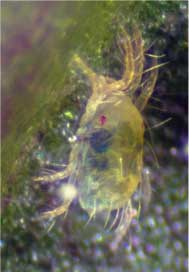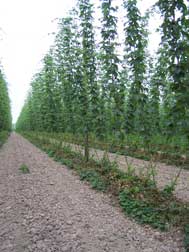Working Together for Hops
Hop (Humulus lupulus) is a major specialty crop in the Pacific Northwest. Washington is the nation’s #1 hop producer, followed by Oregon at #2, and Idaho at #3. The Pacific Northwest is the nation’s leader in hop production; these three states have over 99% of the nation’s hop acreage and about 25% of worldwide acreage. Our project brings the USDA Agriculture Research Service together with the land-grant universities in these three states to address key issues in the region's hop industry.
 Diseases
Diseases
Hops in the Pacific Northwest are susceptible to several diseases that, if left unmanaged, can threaten and diminish the economic viability of hop production. Powdery mildew caused by Podosphaera macularis and downy mildew caused by Pseudoperonospora humuli are among the most significant production concerns for growers. Both types of mildew can affect flowers and cones.
Powdery mildew
Powdery mildew infections at the burr stage can lead to flower abortion, which diminishes fruiting and yield. Cones infected with powdery mildew are stunted and malformed. They mature rapidly, leading to cone shatter and uneven crop maturity. Powdery mildew may impact the biochemical makeup and subsequent taste of the hops.
Downy mildew
Downy mildew infection causes hop flower clusters to shrivel, turn brown, dry up, and sometimes fall. Affected cones become brown. As with powdery mildew infection, downy mildew infection may be detrimental to levels of bittering acids and brewing quality.
 Arthropods
Arthropods
Spider mites and aphids are well documented as important arthropod pests in hop production. Both the twospotted spider mite, Tetranychus urticae, and the hop aphid, Phorodon humuli, feed on plant juices and contaminate cones. Infestations of either pest can lead to yield and quality losses and may contribute to detrimental flavor characteristics. Results of arthropod studies to date are reported on the Entomology pages of this website.
Spider mites
The spider mite is a serious and perennial threat in virtually all PNW hop yards.
Hop aphid
Hop aphid tends to be a sporadic pest in the warmer PNW hop-growing areas. Sooty mold associated with hop aphid honeydew can contaminate the plant and reduces its photosynthetic area. This may result in loss of the entire crop because affected cones can be rendered unmarketable.
California Prionus
California prionus larvae feed on hop roots and can cause yield problems and bine/plant death. This pest is particularly a problem in Idaho.

Healthy hop bines
Industry Needs
- Needs identified 2008 hop Pest Management Strategic Plan workshop
- Manage top pests
- Mites
- Aphids
- Downy mildew
- Powdery mildew
- Address other pest issues as they arise
- Maintain high levels of flavor compounds
Project Objectives
Overall
Investigate the agronomic, biochemical, social, and economic impacts of certain biotic (e.g., spider mite, aphid, powdery/downy mildew, weed) and abiotic (e.g., water shortage/ drought) stresses on hops grown in the Pacific Northwest.
Interaction Effects & Pest Management
Discover the interactions between various irrigation (water-restriction) regimes and the various pest (weed, disease, arthropod) populations.
Food Science
Discover the biochemical and sensory impacts of varying water and pest management regimes.
Socio-Economic Impacts
Model the consumer, economic, and social impacts of the varying agronomic regimes.
Outreach
Reach over 90% of all hop producers in the nation with tools and information designed to help them optimize the quantity, quality, marketability, and sustainability of their high-value specialty crop.
